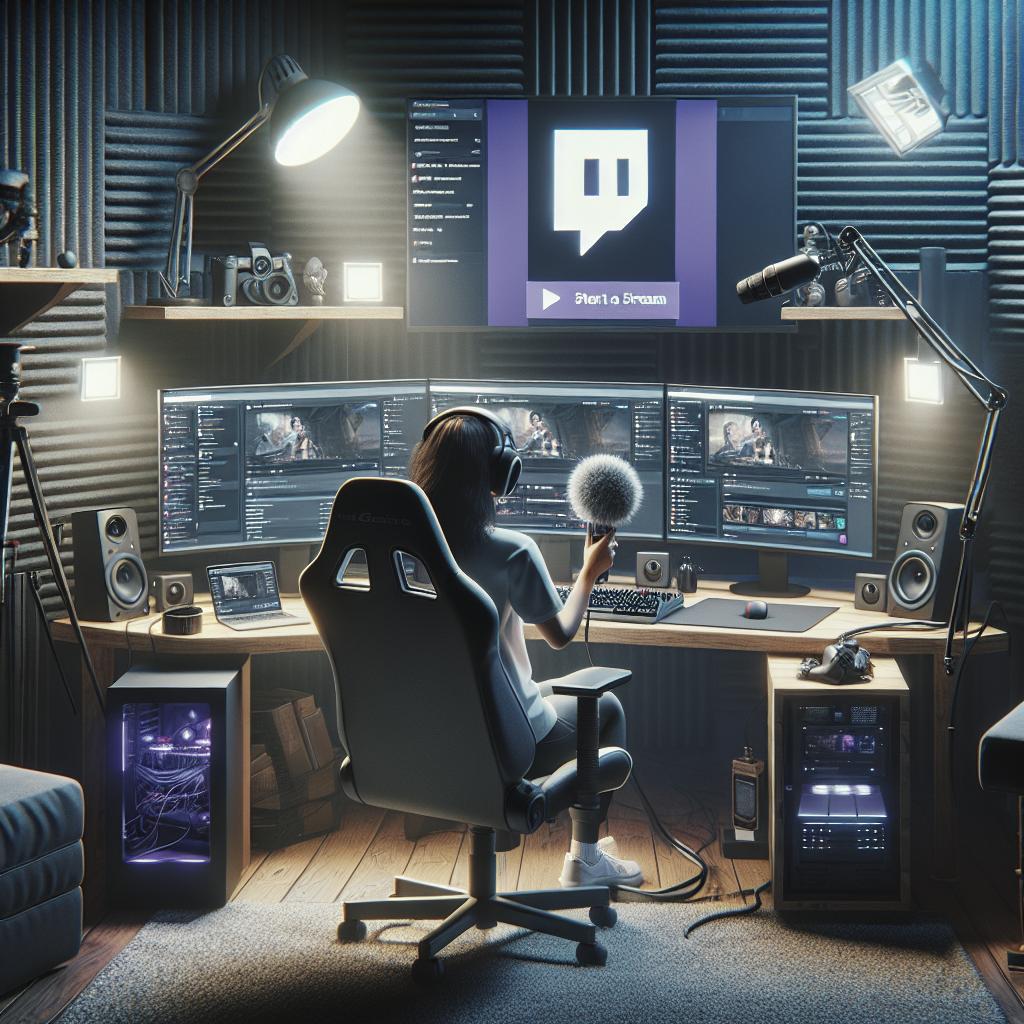“`html
How to Start a Twitch Stream
Embarking on the journey of becoming a Twitch streamer can be both exciting and daunting. This comprehensive guide aims to break down the process into manageable steps, beginning with setting up your Twitch account to getting your streams live on the platform. We delve into the best software and equipment to consider, techniques for streaming from various devices, and guidance on what type of content will engage viewers. Moreover, you’ll find valuable tips for making your stream stand out in the crowded Twitch environment. Whether you’re a novice or looking to improve your streaming skills, this guide offers essential insights to help you achieve your goals on Twitch.
How to create a Twitch account
1. Review the community guidelines.
Before diving into the Twitch universe, it’s crucial to familiarize yourself with the platform’s community guidelines. These rules are designed to foster a respectful community and ensure that everyone can enjoy a positive experience. Thoroughly reviewing these guidelines will help you understand what is expected of you as a streamer and as a member of the Twitch community.
Abiding by these guidelines is essential to cultivating an ethical communication environment. Violations can lead to disciplinary actions, including possible account suspension. Therefore, taking the time to understand these regulations is a fundamental step for anyone looking to stream on Twitch.
2. Create an account.
Creating a Twitch account is a straightforward process that marks the first official step in your streaming journey. Visit the Twitch homepage and click on the ‘Sign Up’ button. Fill in the necessary information such as your preferred username, password, and email address. After providing these details, you’re a step closer to joining the Twitch community.
After registration, it’s a good idea to personalize your profile by setting up a bio and profile picture. This small effort goes a long way in making your channel more appealing to potential viewers, setting a professional tone that could enhance viewer interest and engagement.
3. Enable two-factor authentication.
Safeguarding your Twitch account is vital, and enabling two-factor authentication (2FA) adds an extra layer of protection. By activating 2FA, you ensure that even if your password is compromised, a second form of identification will be required for account access.
To enable 2FA, navigate to your security settings within your Twitch account. You’ll need a mobile device to receive authentication codes, typically through an application like Google Authenticator. This security measure helps keep your account secure against unauthorized access, allowing you to stream with peace of mind.
Which software to use for live streaming on Twitch
Choosing the right software for live streaming can significantly impact your streaming quality and viewer experience. Popular options include OBS Studio, Streamlabs OBS, and XSplit. Each software comes with its own set of features that cater to varying needs, from simple broadcasts to highly customized streams.
OBS Studio is often a favorite for its flexibility and open-source nature. Streamlabs OBS builds on this foundation by offering intuitive overlays and widgets that enhance viewer engagement. XSplit, on the other hand, provides an easy-to-use interface suitable for beginners. Evaluating your needs can help you choose the best software to suit your streaming goals.
What equipment to use when streaming on Twitch
A device to stream from
The first essential piece of equipment is a reliable device, whether it’s a PC, Mac, or gaming console. The device serves as the foundation of your streaming setup. Ensure that your system meets the minimum technical specifications required for streaming.
Investing in a machine with a decent CPU, a solid graphics card, and sufficient RAM can make a significant difference in stream quality. Each component contributes to rendering your content smoothly without lag, providing viewers with an optimal experience.
A microphone
Clear audio is crucial for engaging streams, making a good microphone a necessary investment. While built-in microphones on headsets can work initially, a dedicated microphone can greatly enhance the audio quality, making your stream more professional.
USB microphones, like the Blue Yeti or HyperX QuadCast, are popular among streamers for their quality and ease of use. These microphones capture voice clearly, reducing background noise—an essential feature for maintaining viewer attention.
A webcam
Livestreaming with a webcam establishes a personal connection with your audience, enhancing engagement. A decent webcam enables viewers to see your reactions, which can make streams more entertaining and immersive.
Logitech C920 and Razer Kiyo are among the preferred choices for streamers, offering high-definition video quality. Position your webcam strategically to give viewers a clear and well-lit view of your expressions and surroundings.
Additional streaming gear
Apart from the essential equipment, additional gear like lighting, a green screen, and a capture card can elevate your streaming setup. Proper lighting ensures that your webcam captures vivid, clear images, while a green screen provides a professional backdrop for your stream.
A capture card is beneficial for console gamers, bridging the connection between your console and computer to facilitate seamless streaming. Brands like Elgato offer reliable capture cards that deliver excellent performance.
How to live stream to Twitch from a desktop computer
1. Gather, connect and set up your gear.
Before going live, ensure all your streaming equipment is collected and connected properly. This includes your device, microphone, webcam, and any additional gear. Arrange your setup to allow easy access and minimize distractions during your broadcast.
Finally, conduct tests to make sure all equipment is working. Testing audio and video settings can help address problems proactively, preventing disruptions once you’re streaming.
2. Connect your streaming software to Twitch.
Once your equipment is ready, launch your chosen streaming software. You’ll need to connect this software to your Twitch account, typically by inputting a stream key provided within your Twitch account settings.
This connection allows your live content to be transmitted to your Twitch channel. Securely handling your stream key is essential as it prevents unauthorized broadcasting from your account.
3. Add your sources.
Your streaming software requires you to add sources, such as video capture devices and audio inputs. These sources interpret different media signals, like your webcam feed or game footage, integrating them into your broadcast.
Balancing these sources enhances your stream quality. Arranging them correctly in your software’s interface ensures that each source appears as intended in your stream composition.
4. Find your perfect streaming settings.
Streaming efficiently requires identifying settings that balance your available bandwidth with desired stream quality. Experimenting with variables such as bitrate, resolution, and frame rate is necessary to avoid frequent buffering or poor quality.
Your internet upload speed usually dictates the maximum quality you can stream without issues. Opt for settings that align with Twitch’s recommendations and provide a seamless viewing experience.
5. Customize your Twitch stream with additional features.
Customizing your Twitch stream involves adding overlays, alerts, and widgets to enhance the viewing experience. Platforms like Streamlabs and Streamelements offer a vast array of customization options tailored to your needs.
Overlays and alerts create a branded look, while widgets like chat and donation displays engage viewers directly. This customization allows you to reflect individuality and professionalism, affecting viewer retention positively.
6. Multistream to other streaming platforms.
Multistreaming enables reaching audiences across various platforms simultaneously, significantly expanding visibility. Utilizing services like Restream allows you to broadcast on Twitch and other venues like YouTube or Facebook simultaneously.
However, multi-platform broadcasting can dilute focus and engagement on any single channel. Evaluate whether broadening your reach aligns with achieving quality engagement for your content.
How to live stream to Twitch from consoles
How to stream to Twitch from a PS4
Streaming directly from a PS4 is relatively straightforward, as the console has built-in streaming capability. You can start by linking your Twitch account within the console’s settings, unlocking broadcast options.
When ready, begin by pressing the controller’s ‘Share’ button and selecting ‘Broadcast Gameplay.’ Customize settings like title and camera options to enhance the viewer experience. Finally, initiate streaming to begin sharing your gaming prowess.
How to stream to Twitch from Xbox
Unlike the PS4, Xbox consoles require the Twitch app to start streaming. Download this app from the Xbox store and log into your Twitch account. The app guides you through the setup, helping connect your Xbox live gameplay to Twitch.
Utilizing network settings and adjusting stream quality can further optimize the experience for viewers. Be prepared to adjust settings depending on your internet connection to avoid lag and maintain stream quality.
How to stream to Twitch from a smartphone
For on-the-go streaming, smartphones provide a portable solution. The Twitch app on both iOS and Android supports live streaming, making it easy to connect with your audience anywhere.
Streaming from a smartphone often involves limited options for audio and video enhancements, relying largely on built-in capabilities. Therefore, focus on engaging content and interaction, which can compensate for feature limitations.
What kind of content should you stream on Twitch?
Variety streamer vs. one category
Determining your content is a critical decision affecting your channel’s growth. Some streamers choose a variety approach, exploring multiple games or interests, which can attract diverse audiences while keeping content fresh.
Others specialize, focusing on one game or category to establish expertise. This consistency can build a loyal audience, eager to return for each installment. Weigh pros and cons based on your strengths and audience appeal.
Stream what you love
Streaming should be an enjoyable experience, so prioritize content that you genuinely love. Passion is infectious and can elevate viewer engagement. Audiences can easily discern when a streamer enjoys the content, leading to a more authentic experience.
Balancing personal enjoyment with audience preference might require adjustments, but maintaining enthusiasm can make streaming sustainable and enjoyable long-term.
Choose games carefully
Consider selecting games based on popularity and personal interest. While popular games might bring more viewers, niche games can attract dedicated audiences. Striking a balance helps capture more viewers while ensuring content aligns with your passion.
Your comfort and expertise with a game can determine the viewer experience. Choose titles where your gameplay is engaging or informative, establishing a compelling reason for audiences to join your stream.
Consider a cross-game niche
A cross-game niche focuses on universal concepts, like strategy or speedrunning, applied across various games. Such niches can appeal to audiences interested in certain playstyles, regardless of the specific game.
This approach allows flexibility in content choice, keeping your channel from being tied to the ebbs and flows of any single game’s popularity. It opens doors for creative exploration and caters to a devoted cross-genre audience.
Select content you can generate regularly
Gaining traction on Twitch often requires regular content. Choose a format or game that you can consistently produce to maintain your presence and grow your channel.
Regularly scheduled streams contribute to building a routine that audiences can anticipate, fostering community and helping you meet viewer expectations over time.
More tips for live streaming on Twitch
1. Make your stream look and sound great
Streaming presentation is critical to viewer retention. Use quality gear and software to improve visual and audio output. Simple enhancements like lighting adjustments or using noise-reduction audio tools can make a significant difference.
The professional look and sound of your stream reflect your dedication and make viewers more likely to stay longer, increasing your chances of building a loyal community.
2. Power up your live streaming setup
Invest in upgrades to your primary setup once you’re settled into a streaming routine. Enhancements like additional cameras or upgraded graphics cards can diversify your stream content, producing higher fidelity streams.
Regularly evaluate and refine your setup, striving to offer your audience the best possible experience. Consistent improvement signals seriousness in pursuing streaming, possibly attracting more committed viewers.
3. Follow the rules of Twitch etiquette
Adhering to Twitch etiquette is crucial for long-term success. Engaging meaningfully with your audience and respecting community guidelines demonstrates professionalism and fosters positive interactions.
Reflect on chat behavior, moderation, and fellow streamer interactions. Developing a respectful and supportive community will yield organic growth, as viewers appreciate environments that value their presence.
4. Promote your channel
Marketing your Twitch channel extends beyond the platform itself. Utilize social media platforms, forums, and collaborations to promote your content. Sharing highlights or upcoming streams visual content to entice potential viewers.
Smart promotion includes identifying platforms where your target audience spends time, tailoring communication and engagement to reflect those environments, maximizing reach while deepening audience connection.
FAQs
Q: Do I need a powerful computer for Twitch streaming? A: While a powerful computer can improve stream quality, entry-level setups suffice initially; focus on upgrading components as channel growth requires.
Q: How can I earn money from Twitch streaming? A: Streamers earn through Twitch Affiliate and Partner programs, donations, sponsorships, and subscriptions.
Future prospects
| Topic | Details |
|---|---|
| Create a Twitch Account | Review guidelines, create and secure account with 2FA. |
| Software for Streaming | Consider OBS Studio, Streamlabs OBS, XSplit based on preferences. |
| Essential Equipment | Invest in devices, microphones, webcams, and other gear. |
| Live Stream from Desktop | Setup gear, configure software, customize settings and features. |
| Console Streaming | Direct options for PS4 and app integration for Xbox. |
| Mobile Streaming | Leverage smartphones for portable Twitch engagement. |
| Content Choice | Decide between variety or niche, select engaging streams. |
| Stream Optimization | Focus on quality improvements and rule compliance. |
| Channel Promotion | Leverage social media and engagement for channel growth. |
“`


